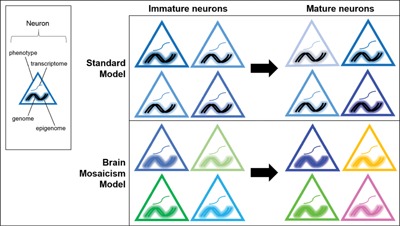Figure 1.

Single cell transcriptomes reflect many aspects of cell state. Cell intrinsic and extrinsic developmental cues lead to some level of neuronal diversity in immature neurons. Activity‐dependent plasticity then further diversifies individual neurons as the brain matures. Standard models of neurodevelopment are based on the assumption that neuronal genomes are static. We propose a brain mosaicism model where neuronal genomes change during development and then further through life, leading to greater levels of neuron–neuron diversity. In tandem with epigenomic modifications and transcriptional regulation, this diversity could perhaps approach a level where every neuron is unique. Schematic of various aspects of cell state: the transcriptome is represented as a single curved line, the genome is represented a double helix, the epigenome is represented as a glow around the genome, and the neuron's phenotype is represented by the border color of each triangle.
